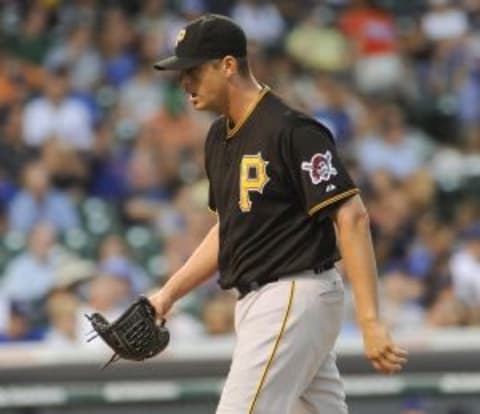Jared Hughes Is Having His Worst Season

Pittsburgh Pirate’s reliever Jared Hughes started off the 2016 season on the disabled list with a lat strain, and he did not start his season off until May 1. Since coming off the disabled list though, Hughes has not been the same pitcher as in the past, and there is some key differences in his performance.
Jared Hughes debut was on May 1st against the Cincinnati Reds in a 6-5 loss. He faced six batters and throwing 19 pitches. Two of the batters he faced walked, one intentionally, and he allowed one run, due to the Pirates defensive having two errors. He only got one groundball, which in a such a small sample is not too worrisome. However, his season as a whole has been.
In 2016, Hughes has pitched in 28 games and 23.2 innings. In those games, Hughes has produced a 4.18 ERA – his worst since 2013 when he appeared in 29 games and 32 innings – his career worst FIP (5.79), his career worst xFIP (5.83), and Hughes has even featured his worst career SIERA (5.38). Hughes’ fWAR (fangraphs) of -0.5 is the worst of his career and his bWAR (baseball-reference) of 0 is the second worst, behind only 2013.
There is more than just these pitching metrics to show show Hughes has just not been himself, and how this is by far the worst season of the 31 year old pitchers career. This season Hughes has gotten the least amount of soft contact (19.8 percent) since 2012 (17.2 percent) and has allowed the highest amount of hard contact in his career (32.6 percent).

Opponents are also not hitting the ball into the ground and have hit the ball into the air far more than at any point in Hughes career. His 51.8 percent groundball rate is 4.5 percent lower than his previous career low (2013). His 28.2 percent flyball rate is 4.9 percent higher than his previous career high (2013). The increase in hard contact and the amount of flyballs, has caused Hughes to have a 2.7 percent home run rate (home runs/plate appearances), a career high.
Another problem of Jared Hughes is the amount of striking out compared to the amount he is walking. A decrease in strikeout percentage has been a trend his whole career. He has gone from 14.1 percent in 2014, to 12.7 percent in 2015, to 9.8 percent this season. His walk percentage this year is the second highest of his career (2013 is the highest) at a rate of 10.7 percent. His strikeout to walk percentage of -0.9 percent is another career low. His 61.5 percent strike rate is the second lowest of his career behind only 2012 (61.0 percent). Hughes has also seen the least amount of 0-2 counts in his career, having only gotten 10.2 percent of plate appearances in 0-2 counts – he has a career mark of 16.2 percent, and his previous career low was 15.2 percent.
Jared Hughes is not doing what he has done best in his career, preventing inherited runners from scoring. He has been presented with 19 inherited runners this season and he has allowed nine of those runners to score, an inherited runner scoring percentage of 47 percent, which is also a career high. In the last three years (2013-2015), he did not allow inherited runners to score. In 2013 only 18 percent scored, 2014 19 percent scored, and last season only 16 percent scored, which over the three year period averages out to 17.27 percent of inherited runners to score. Among the 142 relievers with a minimum of 120 games pitched from 2013-2015, Jared Hughes ranked tenth in inherited runners scoring percentage, and he ranked ahead of top relievers Andrew Miller (11), Craig Kimbrel (15), Darren O’Day (59), and Mark Melancon (60). This season, however, he’s been one of the worst. Among the 137 relievers with a minimum of 15 games pitched and ten inherited runners, Jared Hughes ranks 16th worst.
More from Rum Bunter
- Pittsburgh Pirates Prospect Stockwatch: Outfielder Tres Gonzalez
- Pittsburgh Pirates Podcast: Rum Bunter Radio Talks Winter Meetings Fallout
- Pittsburgh Pirates: Potential Leadoff Hitters in 2023
- Pittsburgh Pirates: The Rotation is not being Improved
- Pittsburgh Pirates Make Vince Velasquez Signing Official
Jared Hughes is no longer leaving the inherited runners on base, and his entering with runners on or no runners has not really changed. This year Hughes has come on to pitch 12 times with runners on base, which is 42.9 percent of the time (12/28). Last season Hughes came in to pitch with runners on 33 times, 43.4 percent of the time (33/76). The difference between last season and this season in those situations is minimal, a difference of only 0.5 percent. In terms of outs per relief appearance, the change from 2015 (2.6) to 2016 (2.5) is minimal.
The way Hurdle has used Jared Hughes really has not varied this season compared to the way Hurdle used Hughes last season. The problem lies within the fact Jared Hughes is not getting ground-balls this season, instead allowing more hard contact and flyballs. Hughes is also having problems with his control which does not help any pitcher. Even with the lower BAbip (batting average in balls in play) in 2016 (.305) compared to 2015 (.315), Hughes is having his worst season of his career.
*Numbers from baseball-reference and fangraphs